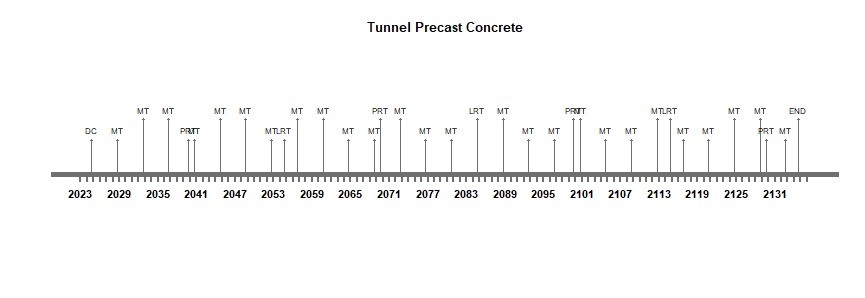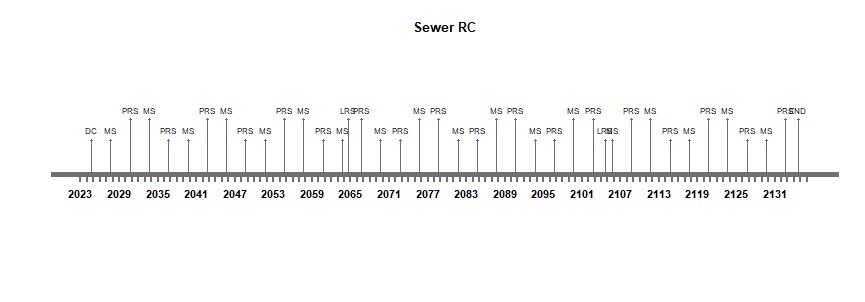The Importance of Adapting Maintenance Strategies for Holistic and Integrated Systems
In complex engineering and infrastructure systems, maintenance plays a crucial role in ensuring long-term functionality, reliability, and cost-effectiveness. As these systems often consist of multiple interconnected and interdependent components, a holistic and integrated approach to maintenance planning is essential. The adaptation of maintenance strategies to fit the specific needs of each subsystem while considering their interdependencies can significantly enhance operational efficiency.
A traditional approach to maintenance often treats individual components or subsystems in isolation, leading to inefficiencies such as redundant maintenance activities, unnecessary downtime, and increased costs. However, by integrating maintenance planning across the entire system, it is possible to optimize maintenance schedules, reduce disruptions, and extend the overall lifespan of assets.
One key benefit of a holistic maintenance approach is the ability to synchronize maintenance activities. By aligning maintenance tasks for interdependent systems, organizations can minimize downtime and disruptions. For example, in infrastructure projects such as bridges, rail networks, or industrial facilities, different systems—such as electrical, mechanical, and structural components—often require periodic inspections and interventions. Instead of conducting separate maintenance operations at different times, an integrated approach allows for the bundling of activities, leading to better resource allocation and reduced operational impact.
Furthermore, adapting maintenance strategies based on real-time data and predictive analytics enhances decision-making. By employing modern monitoring technologies such as IoT sensors, machine learning algorithms, and digital twins, maintenance managers can assess the condition of different systems in real time. This data-driven approach facilitates the identification of optimal maintenance intervals, prevents unnecessary interventions, and ensures that resources are allocated where they are most needed.
Another important aspect of an integrated maintenance strategy is risk management. By understanding the dependencies between various systems, organizations can anticipate potential failure cascades and take proactive measures. For example, in a manufacturing plant, a failure in the cooling system could impact multiple production lines. Recognizing these dependencies allows for preventive maintenance actions that mitigate risks before they escalate into costly failures.
In conclusion, the adaptation of maintenance strategies to account for the holistic and interconnected nature of modern infrastructure and industrial systems is crucial. By integrating maintenance planning, leveraging predictive analytics, and synchronizing maintenance tasks, organizations can achieve significant cost savings, improve asset reliability, and enhance overall system performance. A well-coordinated approach ensures that maintenance efforts are not only effective but also strategically aligned with the broader operational goals of the organization.
Road Tunnel
Regular Maintenance (MT) – Every 4 Years (Duration: 2 Days)
Regular maintenance (MT) every four years is essential to ensure the durability and structural integrity of the tunnel lining. Concrete tunnel linings are exposed to environmental stressors such as moisture infiltration, temperature fluctuations, and chemical exposure from vehicle emissions and de-icing agents. Without periodic inspections and minor repairs, small cracks and surface degradation can escalate into larger structural issues. A two-day shutdown allows for necessary surface treatments, crack sealing, and protective coatings to be applied, minimizing long-term damage and extending the overall lifespan of the lining.
Partial Replacement (PRT) – Every 15 Years (Duration: 10 Days)
Partial replacement (PRT) every fifteen years is necessary to address more significant wear and deterioration in localized sections of the tunnel lining. Over time, repeated exposure to mechanical loads, thermal expansion, and chloride penetration can lead to deeper cracks, spalling, and reinforcement corrosion in certain areas. By replacing damaged sections before they compromise the overall structural integrity, we prevent costly emergency repairs and ensure the tunnel remains safe for public use. The ten-day closure period allows for the removal of deteriorated concrete, application of new reinforcement where needed, and proper curing of replacement material to restore the lining’s load-bearing capacity.
Full Lifecycle Replacement (LRT) – Every 30 Years (Duration: 21 Days)
A full lifecycle replacement (LRT) every thirty years is required due to the progressive deterioration of the tunnel lining materials over time. Concrete linings, despite their durability, experience cumulative stress from cyclic loading, chemical exposure, and aging-related shrinkage, leading to widespread degradation beyond repair. At this stage, large sections of the lining need to be removed and replaced to ensure long-term tunnel safety and functionality. The 21-day downtime is necessary to allow for comprehensive demolition, reinstallation of new reinforced concrete lining, proper curing, and final inspections to ensure compliance with structural and safety standards. This long-term intervention is critical for maintaining the overall serviceability and extending the tunnel’s operational lifespan.
Sewer Network
The maintenance plan for the sewer system is designed to ensure long-term functionality while minimizing disruptions to operations in the surrounding areas, particularly the warehouse and road tunnel. The three levels of maintenance—Routine Maintenance (MS), Partial Replacement (PRS), and Lifecycle Repair (LRS)—are scheduled based on the environmental conditions and expected lifespan of the infrastructure.
Routine Maintenance (MS) – Every 3 Years (Duration: 1 Day)
The sewer pipes are located in an area exposed to chemical contaminants from both the warehouse and the road tunnel. As a result, regular inspections are necessary to detect potential damage caused by chemical exposure. The main tasks during this maintenance phase include visual inspections, minor cleaning operations, and removal of blockages. Since these tasks are relatively simple, the maintenance duration is limited to just one day.
Partial Replacement (PRS) – Every 6 Years (Duration: 5 Days)
Every six years, a more thorough maintenance operation is performed to address cracks, misalignments, and moderate concrete deterioration. These tasks involve small to medium-scale concrete repairs, requiring a curing period before the pipeline can be used again. Consequently, the sewer system is closed for an entire workweek (five days) to allow for proper execution of the repairs.
Lifecycle Repair (LRS) – Every 40 Years (Duration: 30 Days)
The sewer pipeline has a total lifespan of approximately 110 years. To ensure its longevity, two major repairs are planned during its operational period. A third repair would not be necessary, as the pipeline would have reached the end of its expected service life by that time. This repair phase involves extensive interventions, such as excavation and large-scale structural repairs. Given the complexity of these operations, the pipeline is expected to remain closed for 30 days.
Warehouse
Routine Maintenance – Every 10 Years (Duration: 2 Days)
Conducting maintenance every decade is crucial for maintaining the long-term strength and operational efficiency of the warehouse building. Over time, environmental factors such as humidity, temperature fluctuations, and chemical exposure can lead to minor wear on materials like steel, reinforced concrete (RC), and glulam. According to research, regular maintenance helps structural elements outlast the building itself (Alexander & Beushausen, 2019). Cleaning, protective coatings for steel (ict GmbH, 2023), and minor repairs for RC (Lopes & Lopes, 2023) prevent corrosion and deterioration, reducing the risk of costly replacements. The two-day downtime allows for these preventive measures to be implemented without significantly disrupting warehouse operations.
Periodic Replacement – Every 20 Years (Duration: 4 Days)
Periodic replacement every twenty years is essential to tackle localized damage in structural elements that regular maintenance cannot resolve. Research recommends professional inspections every four years for steel and glulam and every five years for RC (Cho et al., 2023), revealing potential issues before they escalate. Steel elements may require section replacements due to fatigue or corrosion, while glulam may need reinforcement or protective treatments (ict GmbH, 2023). Reinforced concrete might develop deeper cracks that require structural repairs (Lopes & Lopes, 2023). A four-day shutdown ensures that compromised sections can be repaired or replaced without jeopardizing the overall integrity of the warehouse.
Full Lifecycle Replacement – Every 30 Years (Duration: 8 Days)
A full life-cycle replacement every thirty years is required to maintain warehouse safety and performance throughout its 110-year lifespan. While no major repairs were required in the 50-year life cycle of the previous system (Baker, 2023), extending the lifespan necessitates periodic large-scale interventions. Continuous exposure to mechanical loads, environmental stress, and material aging leads to inevitable degradation. Replacing major structural elements such as roofing, load-bearing members, and flooring prevents failure and ensures compliance with evolving safety standards. The eight-day downtime accounts for demolition, installation of new materials, curing time for RC elements, and final inspections to secure long-term functionality.
Service Level
With an integrated system of several infrastructures, it is crucial—especially when the systems are highly interdependent—that the entire network maintains a consistently high service level. Any failure or degradation in one subsystem can have cascading effects on the overall performance, leading to inefficiencies, safety risks, and increased operational costs. To achieve this, it is necessary to implement a well-structured and proactive maintenance strategy that ensures components are serviced at appropriate intervals to prevent premature failures. Moreover, when wear and tear exceed acceptable thresholds, complete replacement of critical components becomes essential to sustain reliability and efficiency.
The selected maintenance measures have been carefully planned and coordinated to ensure that the overall system remains continuously at a high level of functionality. By aligning maintenance schedules across the different infrastructures, synergies can be leveraged, minimizing disruptions while optimizing resource utilization. However, bundling maintenance activities also means that the system may temporarily experience a lower service level due to simultaneous interventions. This trade-off between maintaining a consistently high service level and temporarily accepting a reduced functionality must be carefully considered. Depending on the criticality of the system, the economic impact, and safety requirements, it is necessary to assess whether the long-term benefits of coordinated maintenance outweigh the short-term inconveniences. Strategic planning and well-timed execution can mitigate these downsides, ensuring that the overall system remains resilient, cost-effective, and operationally efficient in the long run.



